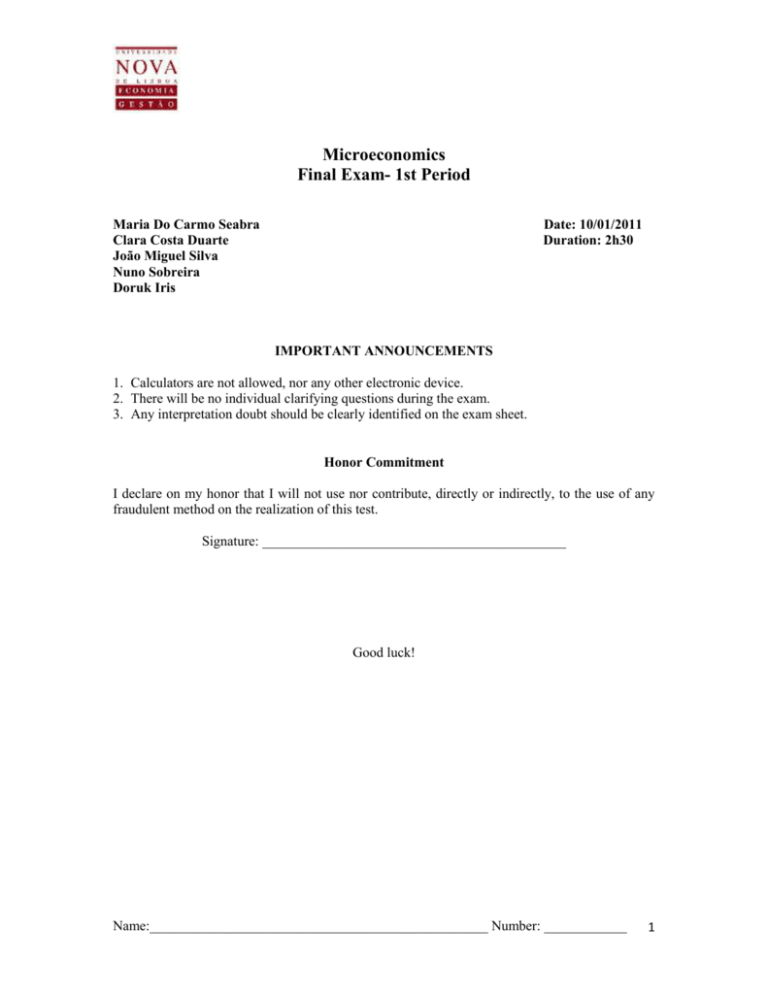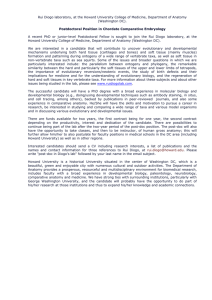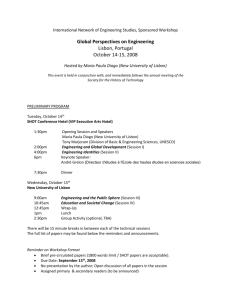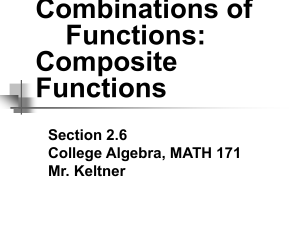fe_1stperiod_10jan11_correction
advertisement

Microeconomics
Final Exam- 1st Period
Maria Do Carmo Seabra
Clara Costa Duarte
João Miguel Silva
Nuno Sobreira
Doruk Iris
Date: 10/01/2011
Duration: 2h30
IMPORTANT ANNOUNCEMENTS
1. Calculators are not allowed, nor any other electronic device.
2. There will be no individual clarifying questions during the exam.
3. Any interpretation doubt should be clearly identified on the exam sheet.
Honor Commitment
I declare on my honor that I will not use nor contribute, directly or indirectly, to the use of any
fraudulent method on the realization of this test.
Signature: ____________________________________________
Good luck!
Name:_________________________________________________ Number: ____________
1
Group I (6)
1- Define a Giffen good. What must be true about a Giffen Good? Explain why this is so
using either algebra or graphics.
A Giffen good has an increasing demand function: when prices increase the quantity demanded
increases as well. A Giffen good is an inferior good ( dx/dM <0) where the positive income
effect outweighs in value the negative substitution effect.
x2
H I
U0
F
XH XI XF
x1
Slutsky equation dxi/dpi = dhi/dpi -xi dxi/dM
where:
dhi/dpi= dxi/dp|U=U0 :substitution effect ( always negative)
-xi.dxi/dM : income effect ( for an inferior good always positive)
If | dxi/dp|U=U0 |< | -xi.dxi/dM | then dhi/dpi > 0
2- Producing good X always requires the use of two inputs. If the prices of inputs are equal
is it always optimal to use these inputs in equal amounts? Explain.
No. The optimal choice of inputs requires that MRST= price ratio.
Depending on the producer technology in some particular cases that may occur ( Ex: Y=KL) but in
general it will not. (Ex: ( Ex: Y=K0.3L0.7)
Name:_________________________________________________ Number: ____________
2
3- What is a “prisoner’s dilemma”? Is the Cournot -Nash equilibrium a “ prisoner’s
dilemma”? Explain.
A “prisoner’s dilemma” occurs in a simultaneous game where the equilibrium of dominant
strategies is not the best solution for both players ( Pareto Efficient).
In a Cournot game competing firms choose the best individual quantity taking into account the
other firm’s choice. In the Cournot-Nash equilibrium each firm is maximizing profits taking into
account the other firm’s choice and vice-versa.
The Cournot -Nash equilibrium is a “ prisoner’s dilemma” because if both firms decide to
cooperate overall profits are always higher.
Group II (5)
Zé Diogo is a Portuguese 3-year old boy. One day he went to the Circus with his parents. He not
only enjoys the show but he is also very interested in what they sell, specially, toys (T) and
popcorn packs (C) which cost 2 € and 4 €, respectively. He enjoys to consume these 2 goods
according to the following utility function:
U(P,T)=C + 5 ln(T)
(Note: It may be useful to know that ln(2)≈0.7 and ln(1)=0).
a. Zé Diogo parents allocated 40 € to be spent on both goods during that day.
Furthermore, at the entrance Mr. Cardinali itself sympathized with such a nice child and
gave him 6 coupons of 2€ each that he can spend (ONLY!) in toys. What is Zé Diogo
Consumption Opportunity Set? What is his optimal choice? Represent graphically.
Consumption Opportunity Set and Graphic Representation (0,75 points):
Optimal choice (0,75 points):
Name:_________________________________________________ Number: ____________
3
b. Suppose instead that Mr. Cardinali sympathized even more with Zé Diogo and
authorized the use of coupons for both goods in the following way: he can trade each
pair of coupons either by 2 toys or by 1 pack of popcorn. What is Zé Diogo new
Consumption Opportunity Set? How much does he want to buy of each good?
Represent graphically.
Consumption Opportunity Set and graphical representation (0,25 points)
Optimal choice (0,25 points):
c. In the next year Zé Diogo and his parents went to the same Circus and happily observed
that the toy's price decreased to 1 €. How did Zé Diogo's surplus change from one year
to another?
Consumer surplus (1 point):
d. Zé Diogo was very happy with this price decrease but unfortunately his parents only
brought 30 € to the Circus on that day. Do you think Zé Diogo will be better or worse off
comparing with the year before? Justify your answer with no calculations making use of
the relevant microeconomic concepts.
Application of the compensating variation concept (1 point):
Since Zé Diogo’s preferences are quasi-linear, good T has no income effect associated with the
price change and so |CV|=|CS|=|EV|. From question c) we conclude that to attain the original
utility level we would have to take away 14 Euros from Zé Diogo’s parents after the price
decrease. So, if we assume that Zé Diogo received 6 coupons this year and the year before,
then he will be better off because ∆M = 30-40 = -10 > -14. If we assume that Zé Diogo only
received the coupons the year before, then he will be worse off because ∆M = 30-(40+12) = -22
< -14.
Name:_________________________________________________ Number: ____________
4
e. Mr. Cardinali wants to substitute the coupons gift from (b) by a new promotional
scheme: for each pack of popcorn bought by Zé Diogo he offers him 1 toy. However Mr.
Cardinali is not quite sure if Zé Diogo becomes happier with this new promotion and he
needs your help. What is Zé Diogo Consumption Opportunity Set with this new scheme?
What is his optimal choice? Represent graphically. Will he be better or worse off relative
to (b)? Justify your answer.
Consumption Opportunity Set and graphical representation (0,75 points):
Optimal choice (0,25 points):
Zé Diogo is better off than in b).
Group III (5)
Consider a competitive industry. There are 100 identical firms, each with costs of
C1 (q) 0,25 q 2 . Market demand is equal to Q A p .
a) Derive the short-run aggregate supply curve. (1 val)
Mc 2q q
p
2
Q 50 p P
Q
50
b) Suppose now that in addition there are 5000 identical firms, each with cost of
C2 ( q ) 2q . Derive the short-run aggregate supply curve for this second group of
firms and then the supply curve of the whole industry. (0,5 val)
Aggregate supply:
Name:_________________________________________________ Number: ____________
5
2q, q 100
p
2, q 100
c) Characterize this firm’s technology in terms of returns to scale. Justify your answer. (1
val)
CRS. MC=AC (for example)
d) Describe the competitive equilibrum if A= 200. Draw three diagrams, one with market
demand and supply and one for each type of firm. (1 val)
Production=98 units.
3 graphics:
1) Type 2 firms (constant MC=2)
2) Intersection between supply and demand at 198.
3) Individual firm (MC, AC, supply, profit).
e) If the government imposes a unit tax of 2 € on this good, what will the new short run
and long run equilibria be? Who bears the tax burden in the short and long run? Justify.
(1.5 val.)
New equilibrium=196.
Impact of tax burden on consumers: in the s.r., l.r.. explain that these effects exist
because supply curve is horizontal.
Name:_________________________________________________ Number: ____________
6
Group IV (4)
The firm Ant-Construction is the only company that rents construction vehicles in a town called
Newland. The total cost of Ant-Construction and the demand for construction vehicles are given
by the following functions:
TC=4q+6
p=36-2q
where p and q stand for the price and quantity of renting construction vehicles, respectively.
a) Assuming Ant-Construction sets a unique price, find the profit maximizing price and
output, and maximized profit of Ant-Construction. Represent graphically. (1 val)
The Monopol’s Problem:
Maxq π=(36-2q)q-4q-6
FOC: dπ/dq=0 36-4q-4=0
qm = 8, pm = 20, and πm = 122
The Graph should have:
-
Price and quantity axes
Demand curve
Horizontal MC curve at 4
MR intersecting MC at p=4 and q=8
Decreasing AC curve always above the MC
Profit or PS of the monopoly
b)
c) The board of the Ant-Construction decides to discriminate their prices in the two
distinct regions of Newland. The demand of construction vehicles in region 1 and 2 are
given by the following functions, respectively: (1.5)
p1=72-6q1
p2=18-3q2
Do you think Ant-Construction can increase its profit if it price-discriminates? Why?
What will be the prices and quantities in each of the regions?
Name:_________________________________________________ Number: ____________
7
Profit with this 2nd degree price discrimination cannot lower be lower than the profit
without any price discrimination. The firm gets the maximum profit from each of these
regions in this way. It charges higher price in the region with less elastic demand. In case
both regions have the same price elasticity of demand, then the firm charges the same
price in both region, which is the monopolist price found in part a.
Firm’s Problem (2DPD):
Max {q1,q2} π = (72-6q1) q1 + (18-3q2) q2 – 4(q1 + q2) - 6
FOC: dπ/dq1=0 72-12q1-4=0
q1 = 17/3 and p1 = 38
FOC: dπ/dq2=0 18-6q1-4=0
q1 = 7/3 and p1 = 11
π2DPD= 38 x 17/3 + 11 x 7/3 – 4 x 8 – 6 = 203 > 122
Yes, the firm has more profit with 2nd Degree Price Discrimination.
d) Having determined the prices for each region in part b), what can you say about the
demand elasticity of each region? (0.5)
The region with lower price has higher elasticity of demand. Thus, the elasticity of demand in
region 1 is less than in region 2.
e)
A consultancy company surveyed the maximum rent price that each of the possible
clients of Ant-Construction would pay and offers the information for €100. Do you think
the Ant-Construction should buy this information? Clearly explain how this information
can be used by the firm to increase its profits. (1)
The Ant-Construction buys this information if it increases its profits such that:
πPD - 100 > π2DPD (or πm )
Under perfect discrimination the firm will increase output while the price exceeds marginal cost
ans will sell each unit at the marginal willingness to pay of each consumer . AtM = 4, the firm
provides 16 units. Thus, the producer surplus is:
PSPD = (36-4) x 16 / 2 = 256
Name:_________________________________________________ Number: ____________
8
The firm has fixed cost of “6”, thus πPD = 250. After paying €100 for the information, the profit of
the firm is €150..
Both of the following answers are considered correct:
i) Since πPD > πm, the firm buys the information.
ii) Since the firm can always price discriminate between two regions and πPD-100<
π2DPD, firm does not buy the information.
Name:_________________________________________________ Number: ____________
9





